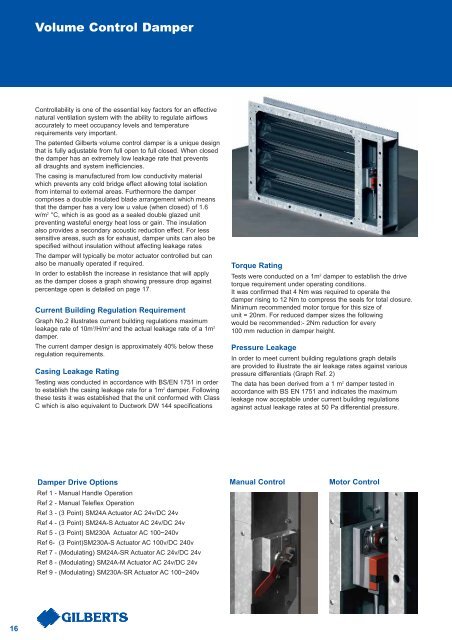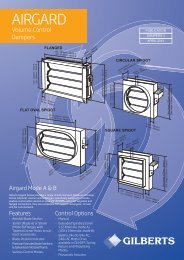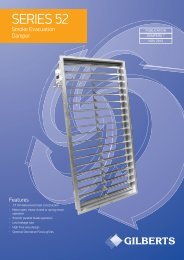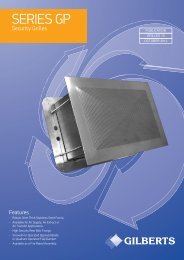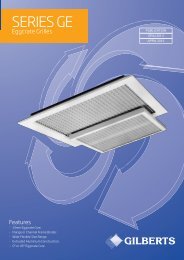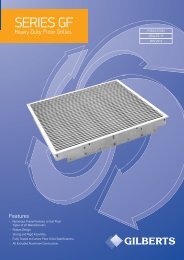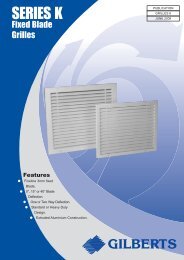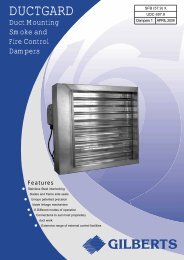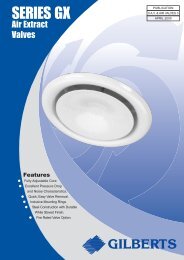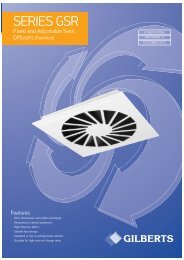NATURAL VENTILATION SYSTEM The Complete Solution - Gilberts ...
NATURAL VENTILATION SYSTEM The Complete Solution - Gilberts ...
NATURAL VENTILATION SYSTEM The Complete Solution - Gilberts ...
You also want an ePaper? Increase the reach of your titles
YUMPU automatically turns print PDFs into web optimized ePapers that Google loves.
Volume Control DamperControllability is one of the essential key factors for an effectivenatural ventilation system with the ability to regulate airflowsaccurately to meet occupancy levels and temperaturerequirements very important.<strong>The</strong> patented <strong>Gilberts</strong> volume control damper is a unique designthat is fully adjustable from full open to full closed. When closedthe damper has an extremely low leakage rate that preventsall draughts and system inefficiencies.<strong>The</strong> casing is manufactured from low conductivity materialwhich prevents any cold bridge effect allowing total isolationfrom internal to external areas. Furthermore the dampercomprises a double insulated blade arrangement which meansthat the damper has a very low u value (when closed) of 1.6w/m 2 °C, which is as good as a sealed double glazed unitpreventing wasteful energy heat loss or gain. <strong>The</strong> insulationalso provides a secondary acoustic reduction effect. For lesssensitive areas, such as for exhaust, damper units can also bespecified without insulation without affecting leakage rates<strong>The</strong> damper will typically be motor actuator controlled but canalso be manually operated if required.In order to establish the increase in resistance that will applyas the damper closes a graph showing pressure drop againstpercentage open is detailed on page 17.Current Building Regulation RequirementGraph No.2 illustrates current building regulations maximumleakage rate of 10m 3 /H/m 2 and the actual leakage rate of a 1m 2damper.<strong>The</strong> current damper design is approximately 40% below theseregulation requirements.Casing Leakage RatingTesting was conducted in accordance with BS/EN 1751 in orderto establish the casing leakage rate for a 1m 2 damper. Followingthese tests it was established that the unit conformed with ClassC which is also equivalent to Ductwork DW 144 specificationsTorque RatingTests were conducted on a 1m 2 damper to establish the drivetorque requirement under operating conditions.It was confirmed that 4 Nm was required to operate thedamper rising to 12 Nm to compress the seals for total closure.Minimum recommended motor torque for this size ofunit = 20nm. For reduced damper sizes the followingwould be recommended:- 2Nm reduction for every100 mm reduction in damper height.Pressure LeakageIn order to meet current building regulations graph detailsare provided to illustrate the air leakage rates against variouspressure differentials (Graph Ref. 2)<strong>The</strong> data has been derived from a 1 m 2 damper tested inaccordance with BS EN 1751 and indicates the maximumleakage now acceptable under current building regulationsagainst actual leakage rates at 50 Pa differential pressure.Damper Drive OptionsRef 1 - Manual Handle OperationRef 2 - Manual Teleflex OperationRef 3 - (3 Point) SM24A Actuator AC 24v/DC 24vRef 4 - (3 Point) SM24A-S Actuator AC 24v/DC 24vRef 5 - (3 Point) SM230A Actuator AC 100~240vRef 6- (3 Point)SM230A-S Actuator AC 100v/DC 240vRef 7 - (Modulating) SM24A-SR Actuator AC 24v/DC 24vRef 8 - (Modulating) SM24A-M Actuator AC 24v/DC 24vRef 9 - (Modulating) SM230A-SR Actuator AC 100~240vManual ControlMotor Control16


